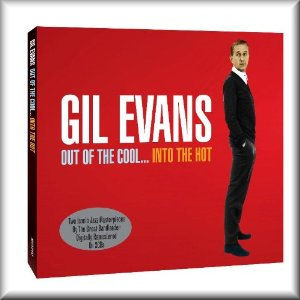CD1
Out Of The Cool
1. La Nevada
2. Where Flamingos Fly
3. Bilbao Song
4. Stratusphunk
5. Sunken Treasure
Gil Evans - Piano
Johnny Coles, Phil Sunkel - Trumpets
Jimmy Knepper, Keg Johnson - Trombones
Tony Studd - Bass trombone
Bill Barber - Tuba
Ray Beckenstein, Eddie Caine - Alto sax, flute, piccolo
Budd Johnson - Tenor sax, soprano sax
Bob Tricarico - Flute, piccolo, bassoon
Ray Crawford - Guitar
Ron Carter - Bass
Elvin Jones, Charlie Persip - Drums
CD2
Into The Hot
1. Moon Taj
2. Pots
3. Angkor Wat
4. Bulbs
5. Barry's Tune
6. Mixed
Tracks 1, 3, 5
John Carisi - Trumpet, arranger, conductor
John Glasel, Joe Wilder (1), Clark Terry (5), Doc Severinsen (3) - Trumpets
Urbie Green, Bob Brookmeyer (1, 5) - Trombones
Jimmy Buffington (3) - Flugelhorn
Harvey Phillips - Tuba
Phil Woods, Gene Quill - Alto saxes
Eddie Costa - Piano, vibes
Barry Galbraith - Guitar
Art Davis - Bass
Milt Hinton - Bass (3)
Osie Johnson - Drums
Tracks 2, 4, 6
Cecil Taylor - Piano
Jimmy Lyons - Alto sax
Archie Shepp - Tenor sax
Ted Curson - Trumpet (6)
Roswell Rudd - Trombone (6)
Henry Grimes - Bass
Sunny Murray - Drums
Caveat Emptor. That is the Latin expression for "let the buyer beware". Despite Gil Evans' picture on the jewel box overwrap with the attached tag line "two iconic jazz masterpieces by the great bandleader", only one of these titles is by Evans and that is Out Of The Cool. Evans had nothing whatsoever to do with Into The Hot and the compositions were not even in the Gil Evans musical framework. But there will be more on this later in the review.
Out Of The Cool was the first album released by Evans after he had completed his collaboration on three Miles Davis gems: namely Miles Ahead, Porgy and Bess as well as Sketches of Spain, all of which undoubtedly altered the concept of jazz arrangements. Success had not come either quickly or easily for Evans. As outlined in the biography of Gil Evans written by Stephanie Stein Crease entitled Gil Evans: Out of the Cool - His Life and Music, the first recordings that featured his arrangements were for the Skinnay Ennis Orchestra in 1939 when Victor issued a 78rpm disc with Side A Garden of the Moon and Side B The Girlfriend of the Whirling Dervish.
So, from this long road emerged the somewhat airy figure that expanded the boundaries of jazz writing and arranging. Of the five tunes on this session, two were Evans originals, namely La Nevada and Sunken Treasure. The first tune comes in at over 15 minutes and really dominates the disc. There is a rhythmic intensity to the arrangement with strong horn punctuation that leads into the various solos with Johnny Coles on trumpet particularly successful, and eventually plays into an extended guitar section by Ray Crawford that burns with originality. On the latter composition, Evans sets up a somewhat darker tone but uses the same ambiance with trumpeter Johnny Coles that was so effective on the Evans/Davis collaboration.
The dense thicket of texture and the harmonic tension that Evans created on his own pieces is also evident in the three other compositions that are presented on the album. Where Flamingos Fly shows off Evans' expressive flexibility with a guitar, flute, tuba and trombone combination which provides a distinctive voice that is briskly assertive in its unique way. Bilbao Song is subtly minimalist yet still effective, and finally George Russell's Stratusphunk takes full measure of the band. While logging in at a meagre 37 minutes, the album nevertheless demonstrates the distinguishing musical influence Evans created.
According to the liner notes, the attachment of Gil Evans' name to Into The Hot is based on the fact that Impulse Records had originally booked studio time for Evans and an orchestra, but since he had not prepared any material, the label turned to trumpeter John Carisi and pianist Cecil Taylor to fill the void, but issued the album under Evans' name. To use a sports analogy, the label took the position "no harm, no foul". As for John Carisi, he was a self-taught trumpeter of little note, with one exception. He penned the composition Israel which Miles Davis recorded as part of his Birth Of The Cool album and also for which Bill Evans had a particular affinity. None of Carisi's compositions written for this session: Moon Taj, Angkor Wat, and Barry's Tune, come even remotely close to the quality of that previously mentioned piece, even though he tries to emulate some of the touches and flourishes that Evans produced with such luminescent ease. Cecil Taylor's efforts are purely in the "avant-garde" style and are not for the faint of heart. While the quality of the musicianship is undoubted and the execution is assertive, it is well beyond anything Evans would have imagined.
The digital re-engineering is bright and crisp and the Evans session alone makes this a worthwhile acquisition.
Pierre Giroux
